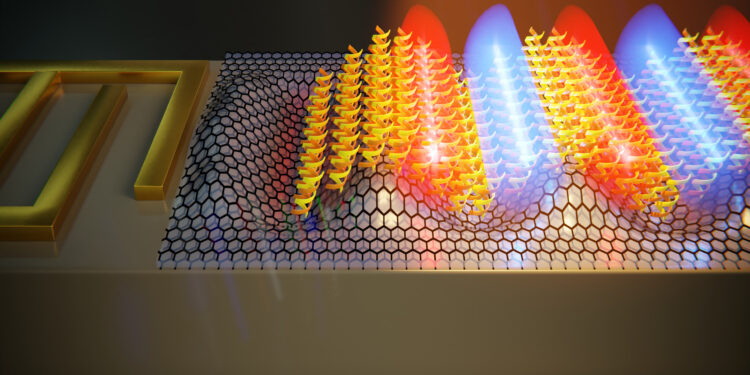A surface acoustic wave launched by an interdigital transducer undulates the surface of the biosensor, confining the light to the nanoscale to make it interact more effectively with the molecules. Credits: Jorge Pedrós, Raúl Izquierdo (UPM) and Enrique Sahagún (Scixel)
A team of researchers from the Institute of Optoelectronic Systems and Microtechnology at the Universidad Politécnica de Madrid (UPM) has designed a biosensor capable of identifying proteins and peptides in quantities as low as a single monolayer. To do this, a surface acoustic wave (SAW), a sort of electrically controlled nano-earthquake on a chip, is generated with an integrated transducer to act on a stack of 2D materials covered with the biomolecules to be detected.
As they report in the newspaper Biosensors and bioelectronics in a paper titled “Surface Acoustic Wave-Driven Graphene Plasmonic Sensor for Fingerprinting Ultrathin Biolayers to the Monolayer Boundary,” the SAW would undulate the surface of a graphene-based stack of such that it confines mid-infrared light to very small volumes, enhancing light-matter interactions at the nanoscale.
In particular, quasiparticles that are part light (photons) and part matter (electrons and lattice vibrations), called surface plasmon-phonon polaritons, form at the wavy stack, interacting strongly with the molecules. at the top.
Organic molecules absorb certain wavelengths of light in the mid-infrared range that are characteristic of their chemical composition and structure. Thus, this set of absorption resonances, called vibrational imprint, allows the identification of the organic compound.
“By enhancing the interaction between light and biomolecules deposited above the sensor, we would be able to identify analytes requiring smaller quantities, reaching levels as low as a single monolayer,” explains Raúl Izquierdo, first author of this study.
According to Jorge Pedrós, lead scientist of the study, “One of the advantages of this mechanism is that the SAWs are actively controlled via a high-frequency voltage, making it easy to switch between an ON configuration, in which the interaction is increased, and an OFF configuration, without any signal improvement. This measurement scheme increases the resolution of the sensor.
“In addition to designing the sensor and calculating its performance, we also propose a mathematical method to extract seemingly hidden quantitative information, thereby increasing the sensitivity of the sensor,” explains Izquierdo.
For this, the analyte molecules and the surface plasmon-phonon polaritons are modeled as oscillators that interact with each other, while both are driven by an external force (light incident on the sensor). Despite its simplicity, this model reproduces the calculation results well.
In conclusion, Pedrós says: “We are confident that this study will contribute to the development of new lab-on-a-chip devices, combining the chemical fingerprinting capability of this new SAW-driven biosensor with other acoustic features such as mass detection based on SAW. or streaming and mixing of droplets in microfluidic circuits.
This story is part of Science X Dialog, where researchers can report the results of their published research articles. Visit this page for more information about ScienceX Dialog and how to get involved.
More information:
Raúl Izquierdo-López et al, Surface acoustic wave-driven graphene plasmonic sensor for fingerprinting ultrathin biolayers down to the monolayer limit, Biosensors and bioelectronics (2023). DOI: 10.1016/j.bios.2023.115498
Jorge Pedrós – Associate Professor, Department of Electronic Engineering and Institute of Optoelectronic Systems and Microtechnology, Universidad Politécnica de Madrid
Quote: Fingerprinting biomolecules using sound (January 22, 2024) retrieved January 23, 2024 from
This document is subject to copyright. Apart from fair use for private study or research purposes, no part may be reproduced without written permission. The content is provided for information only.



